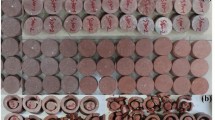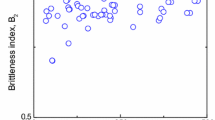Abstract
In drilling operations, the fine drilled cutting are mixed with the drilling fluid. As a result, the properties of the drilling fluid, such as density and rheological properties, will change based on the cutting properties. Previous studies investigated the effect of rock type with different loadings on the drilling fluid properties. However, the effect of cutting’s mechanical properties variation was not addressed. In this paper, the effect of variation in cutting’s mechanical properties on the drilling fluid properties was investigated in sandstone reservoir. Particles of sandstone formation core samples with different compressive strength (UCS) and different Young’s modulus (E) were mixed, in different percentages, with the drilling fluid. The mechanical properties of the cuttings were determined in the laboratory using destructive method. The drilling fluid density and rheological properties were measured using mud balance and 900-Viscometer®, respectively. The results of this work showed that, for sand content less than 10 wt%, the mechanical properties of the drilled cutting have no effect on drilling fluid properties. The effect of the mechanical properties of the drilled cutting becomes more significant for sand content greater than 10 wt%. In this range of sand content (> 10 wt%), for a constant UCS, drilled cutting with a smaller Young’s modulus have a higher effect on the drilling fluid rheological properties compared to drilled cutting with a larger Young’s modulus. On the other hand, for a constant E, drilled cutting with larger UCS showed a higher effect on the drilling fluid rheological properties compared to drilled cutting with smaller UCS values.








Similar content being viewed by others
References
Bourgoyne, J.A.T.; Millheim, K.K.; Chenevert, M.E.; Young, J.F.S.: Applied Drilling Engineering (1991)
Hossain, M.E.; Al-Majed, A.A.: Fundamentals of Sustainable Drilling Engineering. Wiley, New York (2015)
Dai, C.; Zhao, F.: Oilfield Chemistry. Springer, Berlin (2019)
Peden, J.M.; Avalos, M.R.; Artur, K.G.: The analysis of dynamic filtration and permeability impairment characteristics of inhibited water based muds. In: SPE Formation Damage Control Symposium. Held in Lafayette, LA. 24–25, SPE 10655, March (1982)
Hartmann, A.; Ozerler, M.; Marx, C.; Neumann, H.-J.: Analysis of mudcake structures formed under simulated borehole conditions. SPE Drill. Eng. 3(04), 395–402 (1988)
Hodge, R.M.; Augustine, B.G.; Burton, R.C.; Sanders, W.; Stomp, D.A.: Evaluation and selection of drill-in-fluid candidates to minimize formation damage. SPE Drill. Complet. 12(3), 174–179 (1997)
Simpson, J.: Drilling fluid filtration under stimulated downhole conditions. In: SPE ATME Symposium on Formation Damage Control, Held in New Orleans, La., SPE 4779, February (1974)
Murphy, R.; Jamison, D.; Hemphill, T.; Bell, S.; Albrecht, C.: Apparatus for measuring the dynamic solids—settling rates in drilling fluids. In: SPE Annual Technical Conference and Exhibition Held in San Antonio, Texas, USA, SPE 103088, September (2006)
Qin, X.; Lu, H.; Li, Y. et al.: Preparation and evaluation of a profile control agent base on waste drilling fluid. J. Chem. 2017, Article ID 3737510, 7 (2017)
Lee, J.; Tehrani, A.; Young, S.; Nguyen, C.: Viscoelasticity and drilling fluid performance. In: ASME 2014 33rd International Conference on Ocean, Offshore and Arctic Engineering, American Society of Mechanical Engineers Digital Collection (2014)
Mulchandani, V.A.: Experimental analysis on bidispersed cuttings transport in laminar pipe flow. In: SPE Annual Technical Conference and Exhibition Held in New Orleans, Louisiana, USA, 30 September. SPE 167639-STU (2013)
Cayeux, E.; Mesagan, T.; Tanripada, S.; Zidan, M.; Fjelde, K.K.: Real-time evaluation of hole-cleaning conditions with a transient cuttings-transport model. SPE Drill. Complet. 29(01), 05–21 (2014)
Nazri, T.; Hareland, G.; Azar, J.: Review of cuttings transport in directional well drilling: systematic approach. In: SPE Western Regional Meeting Held in Anaheim, California, USA, 27–29 May. SPE 132372 (2010)
Woo, N.; Kim, Y.; Kwon, J.; Chung, S.; Park, E.: A study on the solid-liquid rotating flow for cuttings transportation in inclined annulus. In: International Offshore and Polar Engineering Conference Maui, Hawaii, USA, 19–24 June (2011)
Mahmoud, M.; Bageri, B.S.; Elkatatny, S.; Al-Mutairi, S.H.: Modeling of filter cake composition in maximum reservoir contact and extended reach horizontal wells in sandstone reservoirs. J. Energy Resour. Technol. 139(3), 1–7 (2017)
Kim, Y.J.; Woo, N.S.; Hwang, Y.K.; Kim, J.H.; Han, S.M.: Transport of small cuttings in solid-liquid flow with inclined slim hole annulus. J. Mech. Sci. Technol. 28(1), 115–126 (2014)
Liu, Y.S.; Gao, D.L.; Wei, Z.; Balachandran, B.; Wang, Z.Q.; Tan, L.C.: A new solution to enhance cuttings transport in mining drilling by using pulse jet mill technique. Sci. China Technol. Sci. 62(5), 875–884 (2019)
Piroozian, A.; Ismail, I.; Yaacob, Z.; Babakhani, P.; Ismail, A.S.I.: Impact of drilling fluid viscosity, velocity and hole inclination on cuttings transport in horizontal and highly deviated wells. J. Pet. Explor. Prod. Technol. 2(3), 149–156 (2012)
Coussot, P.; Bertrand, F.; Herzhaft, B.: Rheological behavior of drilling muds, characterization using MRI visualization. Oil Gas Sci. Technol. 59(1), 23–29 (2004)
Saasen, A.; Løklingholm, G.: The effect of drilling fluid rheological properties on hole cleaning. In: Drilling Conference Held in Dallas, Texas, 26–28 February. IADC/SPE 74558 (2002)
Saasen, A.; Omland, T.H.; Ekrene, S.; et al.: Automatic measurement of drilling fluid and drill-cuttings properties. SPE Drill. Complet. 24(4), 4–6 (2009)
Bageri, B.S.; Elkatatny, S.; Mahmoud, M.; Al-Majed, A.: Impact of sand content on filter cake and invert emulsion drilling fluid properties in extended reach horizontal wells. Int. J. Oil Gas Coal Technol. 19(2), 135–148 (2018)
Bageri, B.S.; Mahmoud, M.; Al-Mutairi, S.H.; Abdulraheem, A.: Effect of sand content on the filter cake properties and removal during drilling maximum reservoir contact wells in sandstone reservoir. J. Energy Resour. Technol. 138(3), 032901-1–10 (2016)
Davison, J.M.; Daccord, G.; Prouvost, L.P.; Gilmour, A.: Rig-site monitoring of the drilling fluid solids content and solids-control equipment discharge. SPE Drill. Complet. 14(2), 130–138 (1999)
Omland, T.H.; Saasen, A.; Taugbol, K., et al.: Improved drilling process control through continuous particle and cuttings monitoring. In: SPE Digital Energy Conference and Exhibition Held in Houston, Texas, USA, SPE 107547, April (2007)
Pitoni, E.; Ballard, D.A.; Kelly, R.M.: Changes in solids composition of reservoir drill in fluids during drilling and the impact on filter cake properties. In: SPE European Formation Damage Conference, The Hague, Netherlands, SPE 54753, June (1999)
Xu, P.; XiongH, PuX; Liu, J.; Liu, X.: Polymer drilling fluid with micron-grade cenosphere for deep coal seam. J. Chem. 2015, 967653 (2015)
Bageri, B.S.; Al-Majed, A.; Al-Mutairi, S.H.; Ul-Hamid, A.; Sultan, A.: Evaluation of filter cake mineralogy in extended reach and maximum reservoir contact wells in sandstone reservoirs. In: Drilling Conference and Exhibition Held in Amsterdam, The Netherlands, SPE/IADC 163519, March (2013)
Bartlettt, L.E.: Effect of temperature on the flow properties of drilling fluids. In: Annual Fall Meeting of the SPE of AIME, Held in Kuston, Tex., SPE 1861, October (1967)
Bland, R.; Mullen, G.; Gonzalez, Y.; Harvey, F.; Pless, M.: HP/HT drilling fluids challenges. In: Asia Pacific Drilling Technology Conference and Exhibition Held in Bangkok, Thailand, IADC/SPE 103731, November (2006)
Bouse, E.E.; Carrasquero, J.E.: Drilling mud solids control and waste management. In: SPE Latin America Petroleum Engineering Conference, Caracas, Venezuela, SPE-23660-MS, March 1992 (1992)
Liang, T.; Gu, F.; Yao, E.; Al, E.: Formation damage due to drilling and fracturing fluids and its solution for tight naturally fractured sandstone reservoirs. Geofluids, 2017, Article ID 9350967, 9 (2017)
Tare, U.A.; Takach, N.E.; Miska, S.Z.; Growcock, F.B.; Davis, N.: Investigation of drilling fluids containing blast furnace slag for their potential impact on formation damage-a laboratory study. J. Energy Resour. Technol. 121(3), 149–153 (1999)
Nunes, M.; Bedrikovetsky, P.; Newbery, B.; Paiva, R.; Furtado, C.; de Souza, A.L.: Theoretical definition of formation damage zone with applications to well stimulation. J. Energy Resour. Technol. 132(3), 033101 (2010)
Ding, Y.; Renard, G.: Evaluation of horizontal well performance after drilling-induced formation damage. J. Energy Resour. Technol. 127(3), 257 (2005)
Bageri, B.S.; Mahmoud, M.A.; Al-Mutairi, S.H.; Abdulraheem, A.: Filter cake porosity and permeability profile along the horizontal well and their impact on filter cake removal. In: International Petroleum Technology Conference Held in Doha, Qatar, IPTC- 18465, December (2015)
Bageri, B.S.; Mahmoud, M.A.; Sultan, A.S.; Al-Mutairi, S.H.; Abdulraheem, A.: Effect of the drilled cuttings on filter cake sealing properties and internal invasion depth in MRC wells. In: Oil & Gas Show and Conference Held in Mishref, Kuwait, SPE-175168, October (2015)
Zhao, K.; Gu, S.; Yan, Y.; Li, Q.; Xiao, W.; Liu, G.: Rock mechanics characteristics test and optimization of high-efficiency mining in Dajishan Tungsten Mine. Geofluids 2018, 8036540 (2018)
Bageri, B.S.; Benaafi, M.; Mahmoud, M.; Patil, S.; Mohamed, A.; Elkatatny, S.: Effect of arenite, calcareous, argillaceous, and ferruginous sandstone cuttings on filter cake and drilling fluid properties in horizontal wells. Geofluids 2019, 1–10 (2019)
Author information
Authors and Affiliations
Corresponding author
Rights and permissions
About this article
Cite this article
Bageri, B.S., Benaafi, M., Mahmoud, M. et al. Effect of Formation Cutting’s Mechanical Properties on Drilling Fluid Properties During Drilling Operations. Arab J Sci Eng 45, 7763–7772 (2020). https://doi.org/10.1007/s13369-020-04424-7
Received:
Accepted:
Published:
Issue Date:
DOI: https://doi.org/10.1007/s13369-020-04424-7




